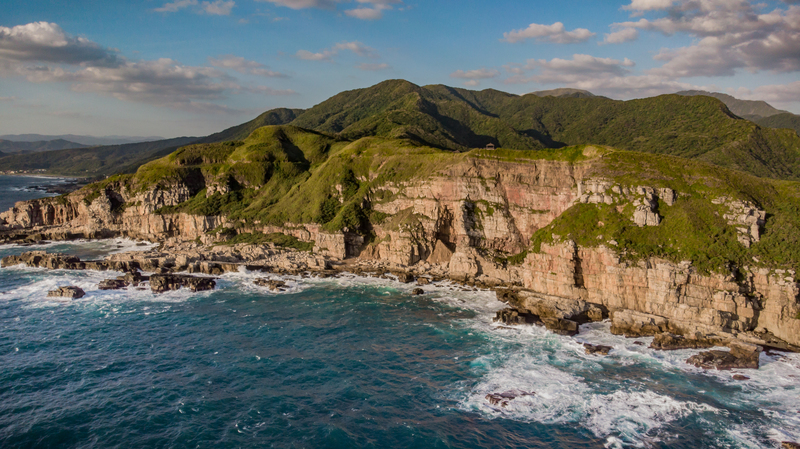While on vacation in Taiwan last July, we spent three days hanging around Long Dong — Taiwan's northern climbing congregation. The windswept crags offer plenty of great trad and sport climbing, even for us top rope folk.
The lay of the land
Long Dong (LD for short, literally 龍洞 "Dragon Cave" in Mandarin) refers to a series of cliffs in the northeast of Taiwan. LD faces the Pacific Ocean, right next to a fishing village called Bitou (鼻頭角), in Ruifang District, New Tapei City. Long Dong's vast cliffs — two kilometers's worth of uninterrupted crags and routes — have drawn climbers of all sizes, levels, and nationalities, like moths to a flame.
Climbing at Long Dong means scaling dense conglomerate, a type of sedimentary rock made of rounded pebbles and sand that is held together by silt, clay, or the like. LD's conglomerate is made of dense quartz, giving the rock a pocked, gritty texture with the occasional gleam of quartz – but the features are not so fine that your fingers will flay themselves raw on every surface. LD isn't the place to show off your flappers. With a grittiness and hardness in between granite and limestone, climbing is a confident, relatively bloodless affair unless you jam your fingers while crack climbing in one of Long Dong's caves. At no point were we struck with the sudden fear that a rock would come loose (that belies me and my partner's inexperience – sedimentary rock, after all, isn't as hard as igneous.) In that sense, LD is great for those relatively new to the sport. It won't scare anyone off that way.
The rock comes in many different shades of red, yellow, gray, and blue. The time of day bathes the cliffs in different colors and temperatures – depending on the weather, the holds will be reddish and warm, or cool both in sight and touch. The lighting brings Maxfield Parrish to mind, or a Yes album cover.


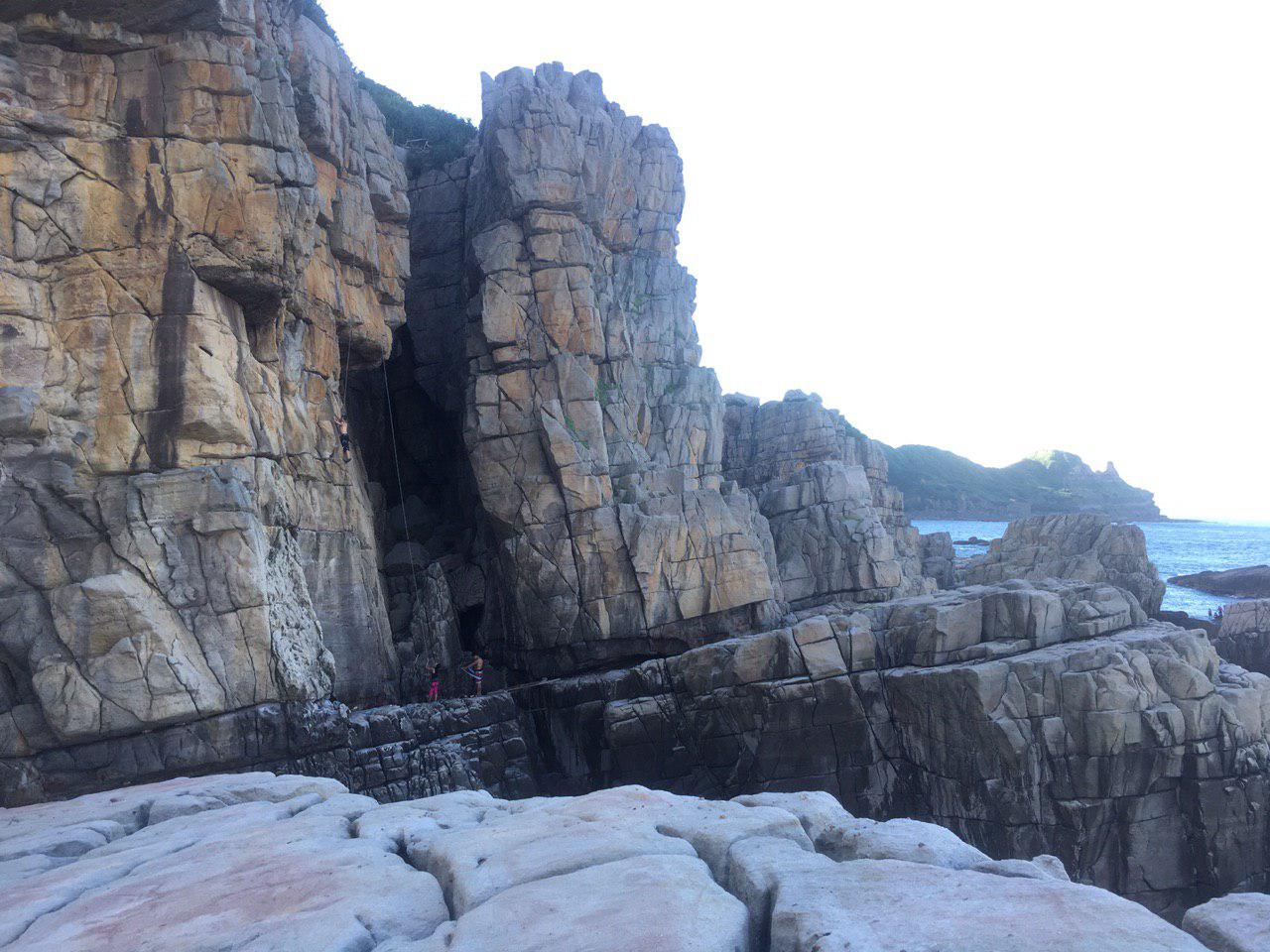
The weather and local fauna determine LD's climbing season. If you share in the postman's motto, neither rain, nor heat, nor snow then barring a storm or the local peregrine nesting season (in between February and June), you'll be fine. For those looking for ideal weather conditions, fall and spring offer a reprieve from the sun's warmth, which you can expect to feel for most of the day.
We went in August, and being from the tropics, did not have to acclimate to the heat. It rained for a bit in the morning, which meant crack climbing in an area called First Cave. The skies cleared up in the afternoon, leading us to Music Hall. After a few hours we had another reason to appreciate Long Dong: the relative lack of mosquitoes. If you can stand the heat, climbing during the summer (July/August) is not a bad thing at all.
So far, everything I've said is in favor of the dilettante, the gym rat, the newbie — those who want to get their feet wet for the first time with an outdoor climb. However, LD, being by the seaside and exposed to the salt water, means that bolts must be maintained (and they are, with glued titanium bolts). From what we've gathered, there are more trad routes than sport routes partially due to both environmental concerns and safety concerns. I believe that trad climbers will be able to appreciate the flame of LD the most, while the rest of us moths lack the finer apparatus for that level of appreciation. Still, Long Dong is great outdoor climbing with what routes have anchors and bolts — after all, there are almost six hundred routes. It would take months or years for climbers to exhaust every sport climb in LD.
Getting there & sticking around
We took the long-distance Kuokuang 1811 bus from just outside of Taipei Main Station to LD. We used a Taiwan bus app that provided live updates as to where we were during the ride in both English and Mandarin. Note that the Kuokuang bus has its own terminal across the street from Taipei Main Station's East Exit. We took the last available bus, at around 17.40, and arrived in time for dinner at around 19.30. Don't forget to press the switch next to your seat after passing through Nanya Nanxin station, to tell your conductor that you'll be getting off at the next station, which is Bitou. You'll be dropped off at a parking lot just past a tunnel.
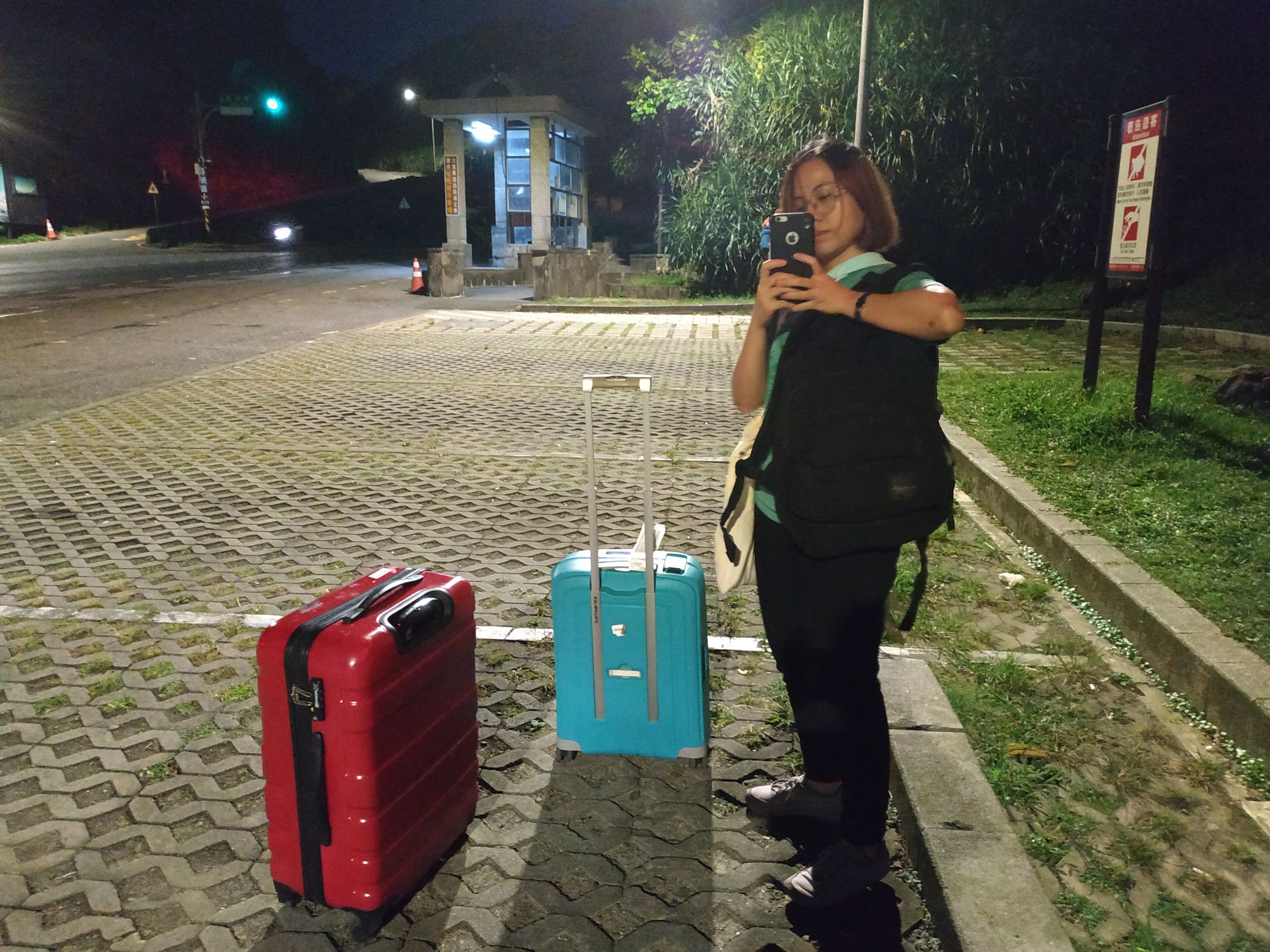
As an aside, you'll want to arrive earlier at Bitou to catch the local eateries and get a feel for the area.
Both Crack House and the Bivy are long-running and well-established hostels for climbers. We went with the Bivy as QX and Kelly also offered guiding services, but we hope to return and meet the folk at Crack House too. The Bivy is about twenty minutes away from the cliffs. The folk there show you all the ropes: where to go for breakfast, how to make your way from one entrance to the other, and so on. The surrounding villages/towns such as Jiufen and Ruifang both offer accommodation and easy transport as well, though we haven't tried.
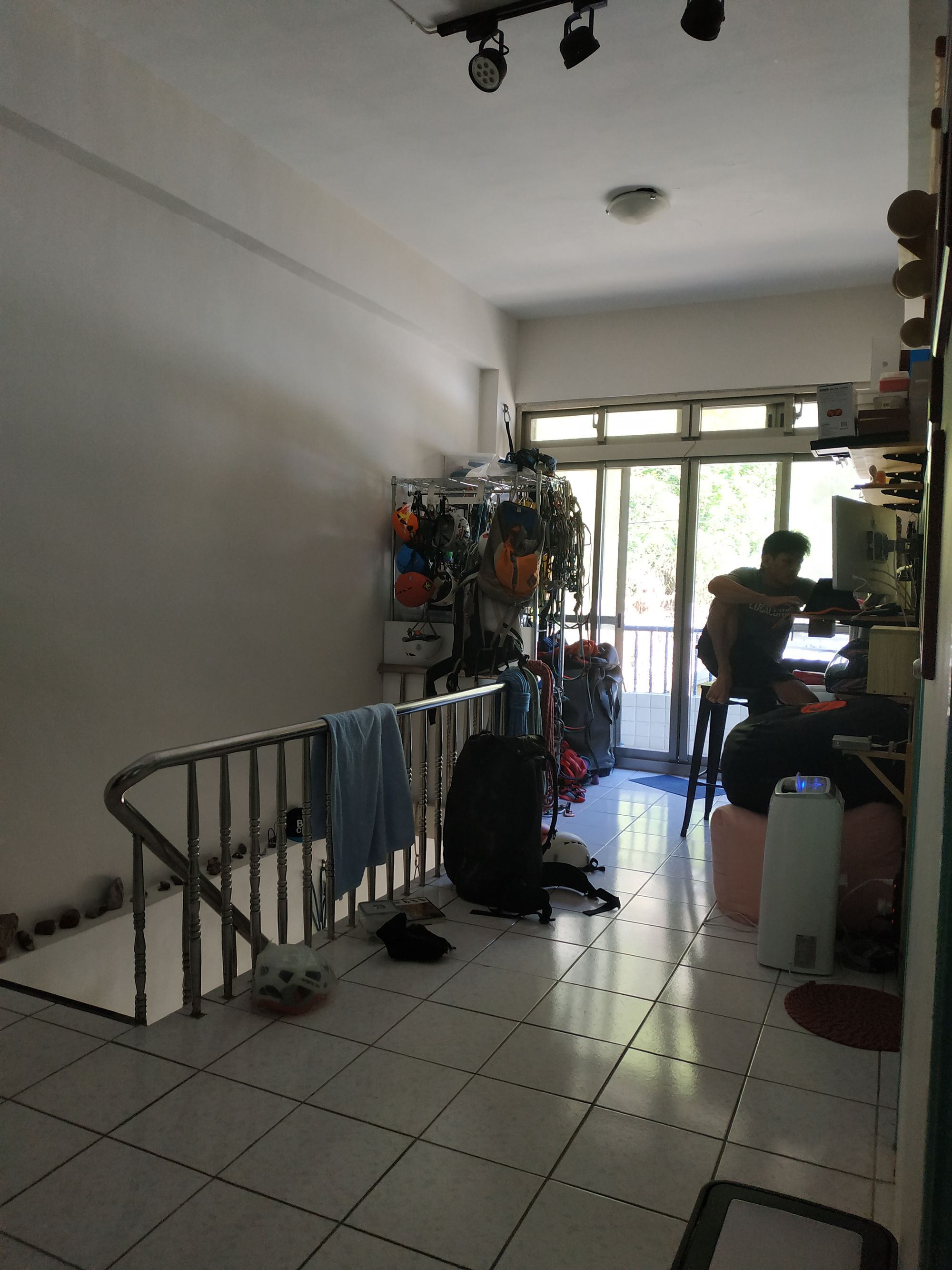
The Bivy stands out along Bitou street as one of the tallest buildings in the area. Four storeys high, the first floor has a kitchen and living room, and rooms in the next two floors. We were the only guests staying. We were told in advance that that QX and Kelly were on a trip on their own, and that they had booked a guest guide for us — Mervil, who was on the same flight from the Philippines we were on. In addition to learning a bit about Long Dong, we also learned about climbing at Cebu, Mervil's home base. Cebu, specifically a town called Cantabaco, is known for its limestone climbing, with faces full of chalk-white pockets that are easy on the fingers. (Climbing at Cantabaco is also on our list, but Taiwan went first for the simple reason that we were seeing friends in Taiwan as well.)
Sticking around — getting fed, watered, and keeping alive — boils down to lots of pointing, learning some Mandarin, and common sense. One of the first, most visible spots to eat at is a 7-11, an illuminated box of familiarity. We ate there at least twice because the local eateries had already closed for the day. There are restaurants open till quite late, but those restaurants wouldn't necessarily be in-budget: Bitou is a popular destination for families over the weekend, drawn to the fresh seafood, the beach, and good hiking. Of those restaurants, we told oursevles we'd go if after climbing we had cash left, but the opportunity didn't arise.
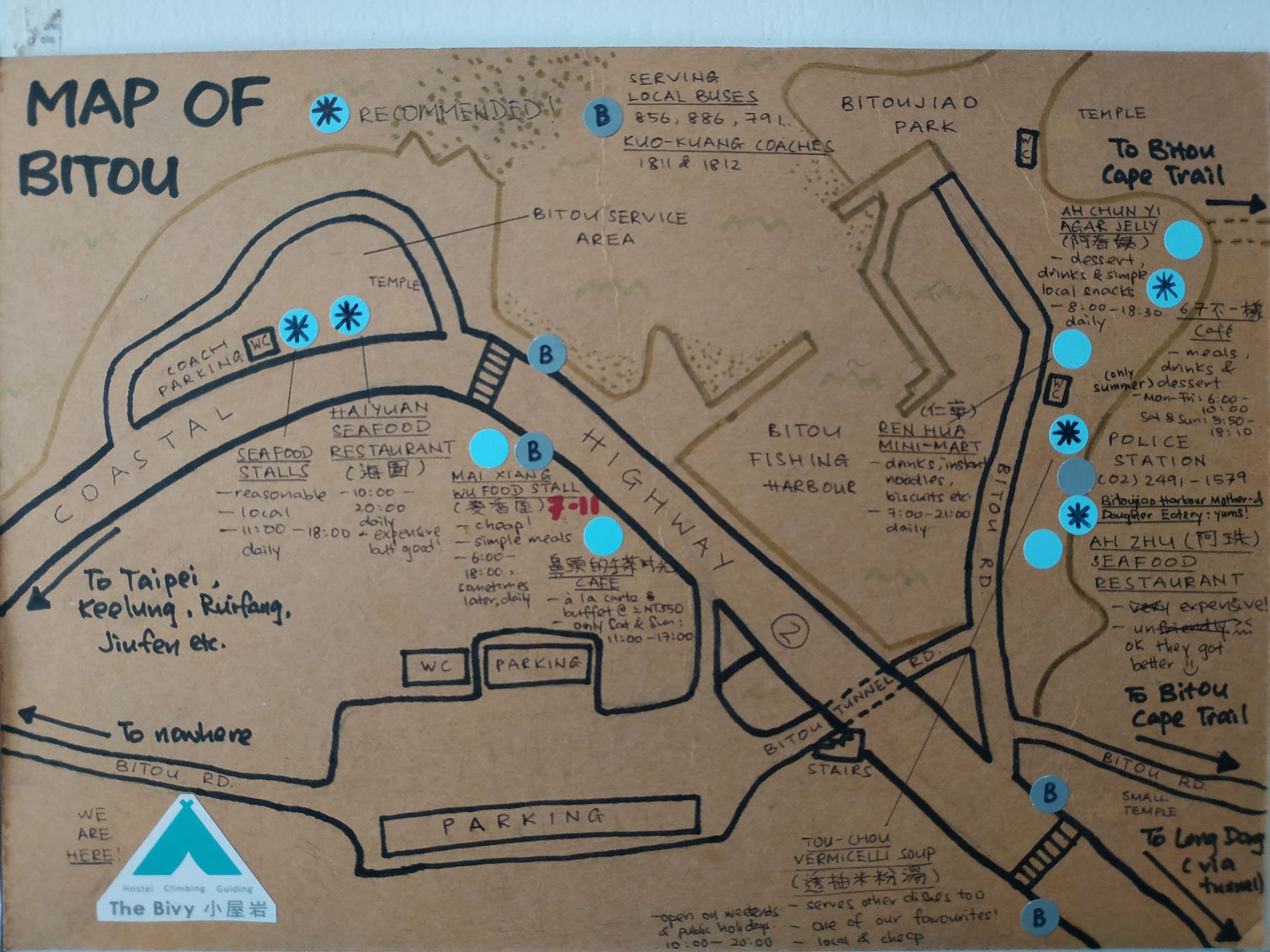
Climbing logistics
Climbing on a dime is an option in Long Dong.
Having done that, we'd recommend loosening the purse strings a bit. This may not always be a possibility; LD was the cherry on top of our own Taiwan trip, but it wasn't the brownie or the ice cream, and so we budgeted without much thought. That being said, LD is one of those places where a slight adjustment in cost yields a great increase in fun.
If the catch is fresh — pay for it! And if the weather and birds agree — stay the week while it lasts! Long Dong is the place to try out another climbing style. You could eat the cheapest thing on the menu, or eat the one thing you vaguely recognize or can pronounce, but you'll come with the sense that you missed out on a side-quest.
Long Dong offers single-pitch and multi-pitch climbing as well as crack climbing and bouldering. Different areas of LD also offer slight differences in rock. Consider your options and what you haven't tried. If you'd rather not lug equipment for trad (completely understandable), you could bring tape to try out crack climbing before writing it off completely or discovering something new about your abilities.
Gearing up
You have the option of renting equipment from either Crack House or the Bivy, but for sport climbing, you may want to bring your own gear and rent to fill out your kit. It's worth it to bring the following:
- A rack of quickdraws (about 12 for single-pitch routes)
- Harness and shoes
- Belay device and carabiners
- Tape
- Kernmantle (dynamic) dry-treated rope, about 60m for single pitch
Unless you want to make outdoor climbing a habit, renting a helmet is recommended rather than buying one. The real world is not a gym, and loose stones are a real hazard at Long Dong.
Additional gear you may want to bring:
- Your own containers for lunch and water (remember not to toss anything out while at LD)
- A picnic mat, for your friends who may not be into climbing, but would like to experience the trail
- Hiking shoes with good traction, for scrambling down to the cliffs
- A broad-rimmed hat for the heat
- Sunblock
Approaches & climbs
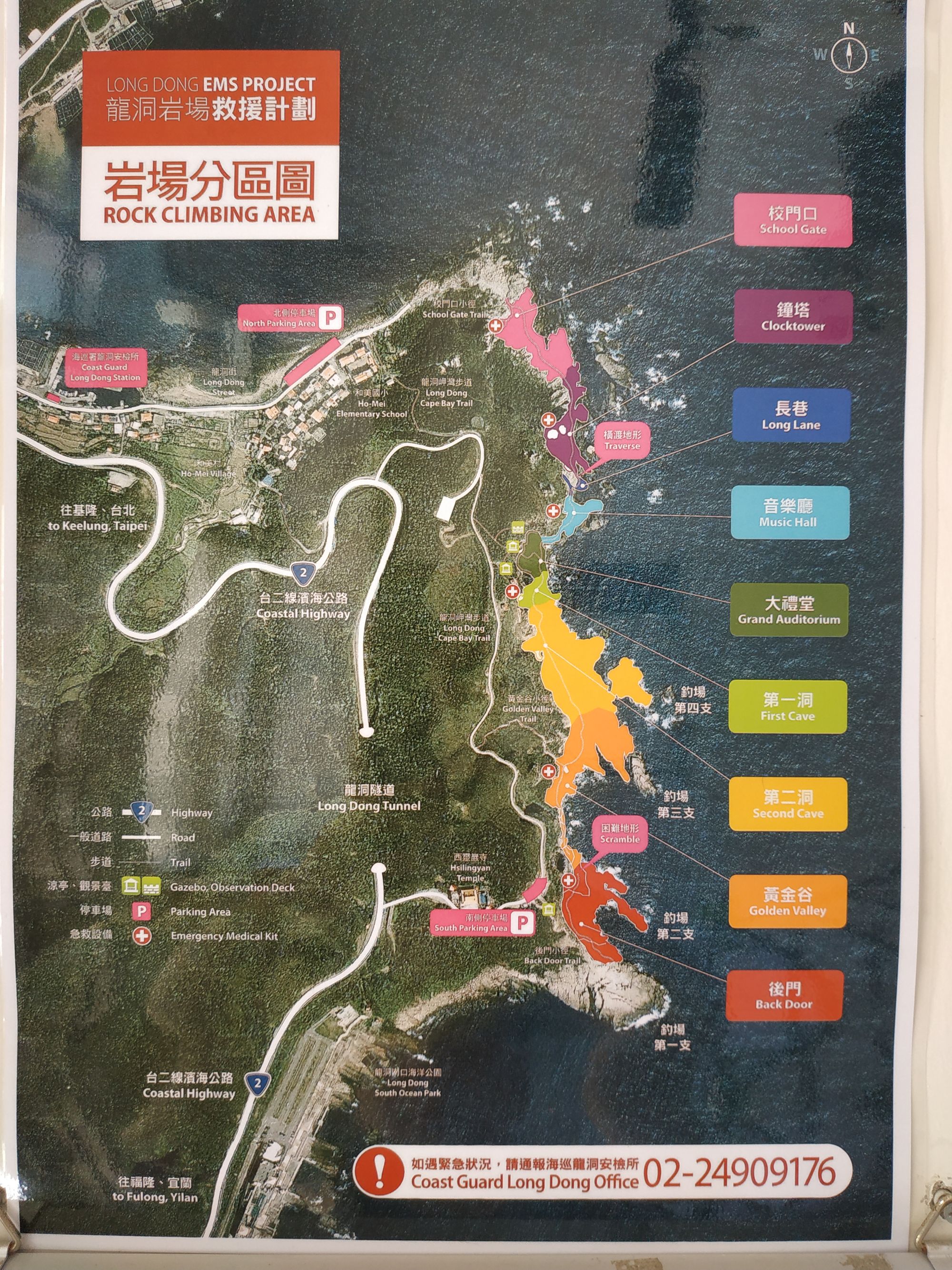
There are two approaches to Long Dong: the North Entrance (close to Hemei Elementary School) and the South Entrance, close to a Buddhist temple. We took the South Entrance, which took us first to the Back Door area. There's a place you can go to buy food right before you start (and the food will still be warm by the time you're hungry!) On the trail path, you'll see a sign pointing downwards away from the trail, which marks the start of a scramble downwards through white rock and tall grass. While not a steep scramble, exercise caution or your trip to Long Dong will end early with a sprained ankle. From there it is a well-worn path to the cliffs.
Our first stop was at the caves. The morning rain was strong, but petered out in the afternoon, allowing us to do some classic routes, such as Wedding Day. On the average, as weekend climbers, we could do maybe four or five routes max. Your own experiences will depend on how large your party is, how many pitches you'll be aiming for, and how high the single-pitch routes are.
Our climbing day ended at about 16.30. We exited through the North Entrance, passing through the traverse (marked in pink in the photo above).

References
- List of stops for the 1811 bus: https://www.taiwanbus.tw/eBUSPage/Query/QueryResult.aspx?rno=18110&rn=1636721152168
- From bivy: https://apps.apple.com/tw/app/taiwan-bus/id1163101845?l=en
- Mountain project:
